Archives
we look to the future with progressive ideals - ‘Māramatanga’ (enlightenment)
Welcome, to this the 5th instalment in this 6-month project where I have had the utmost joy and privilege to curate the work of 8 female and non-binary artists who, I believe, posit both as individuals and collectively a way to look to the future with progressive ideals. Here in Aotearoa, New Zealand, it is Matariki (The Māori New Year). As someone who has settled in Aotearoa with mixed northern hemisphere ancestry, my understanding of Matariki is through reading and conversations. From this, I have learned that it includes acknowledging ancestors and the passing of loved ones in the last lunar year and looking to the coming year's abundance in the planning of the next growing seasons. The cold of winter brings with it a time for reflection, and the warmth in connecting with our family and community, and looking to the year ahead. I recently read on @tepapa one of the more popular legends relating to the star cluster Matariki which I would encourage you to explore further. "The star Matariki is the whaea (mother), surrounded by her six daughters, Tupu-ā-nuku, Tupu-ā-rangi, Waipunarangi, Waitī and Waitā, and Ururangi. Matariki and her daughters journey across the sky each year to visit their tupuna wahine (female ancestors). During this visit, each of the stars help Papatūānuku to prepare for the year to come, using their unique qualities or gifts to bring mauri to her different environments. Whilst spending time with their kuia (elder), they also learn new skills and gain new knowledge from her, which they guard and pass on to others." From the inception of this project, I had the artist @fog_moon_studio Tanya Te Miringa Ruka's work in mind for this time, and I am excited that that time is now. When I think about the contribution of Tanya to both me personally and the communities she builds around her, they are abundant. This abundance comes in many forms and always includes knowledge, collaboration and care. Tanya's work straddles learnings from her tupuna as she navigates her relationship with the world around her whilst creating a pathway to a future that is necessary and will benefit all.
Tanya Te Miringa Ruka -Ngati Pakau, Ngapuhi, Waitaha
Tanya is a Māori Indigenous artist with a deep interest in indigenous ancestral navigational systems. ‘I nga wā o mua’ from times in front: thinking through Futures design using ideas of science fiction, fantasy and allegory to open pathways of potential located within indigenous futurism, eco futurism and alternative worlds.
‘Māramatanga’ (enlightenment).
Digital weaving of Whau river from the air.
HD video, drone footage 2020
Māramatanga is part of a community art project I have been working on in the Whau, Tāmaki Makaurau. ‘Raranga, Rerenga, Rauropi | Weaving Biodiversity in our own Backyard’. Māramatanga is 1 part of 3, ‘Kaitiakitanga’ and also ‘Manākitanga’ digital weavings filmed in the Whau. Working within my art practice I have been evolving my own understanding of connection to the natural world. I found in times of trauma, surrounding elemental Tohu or signs would bring me great relief little things that would catch my attention, like sunlight on the water, kahu circling in the sky or a glint of mokomoko skink through the grasses. I found myself paying more attention to these momentary gifts from the natural world reconnecting with the wairua essence and spirit of nga whenua the land. This community art project was designed as work that would continue to learn, evolve and grow through interactions with the land and people. Mauri is the lifeforce of every living being, land, people and communities. Looking to the future, how do we protect, preserve and enhance the Mauri? My grandmother taught me that when you approach a tree or plant for rongoa or healing, you must ask first if it is willing to share with you its life force, and most importantly you must wait for its response.
These digital weavings represent personal geospatial markers, documenting time spent in place.
we look to the future with progressive ideals - E Hoa
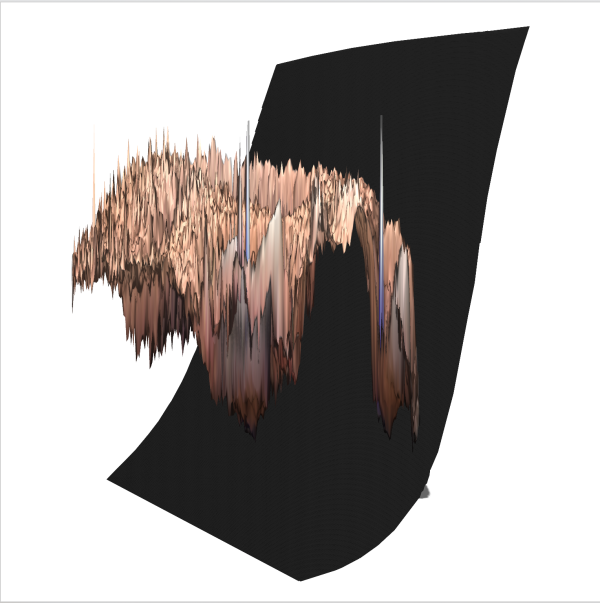
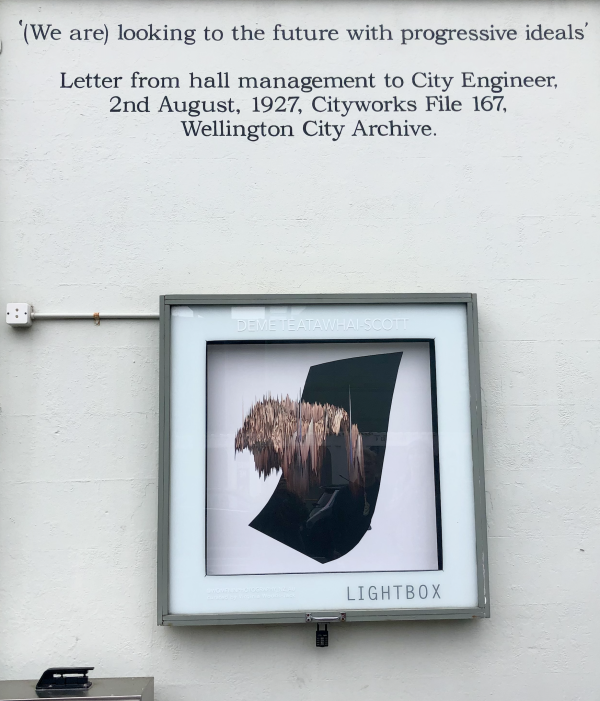
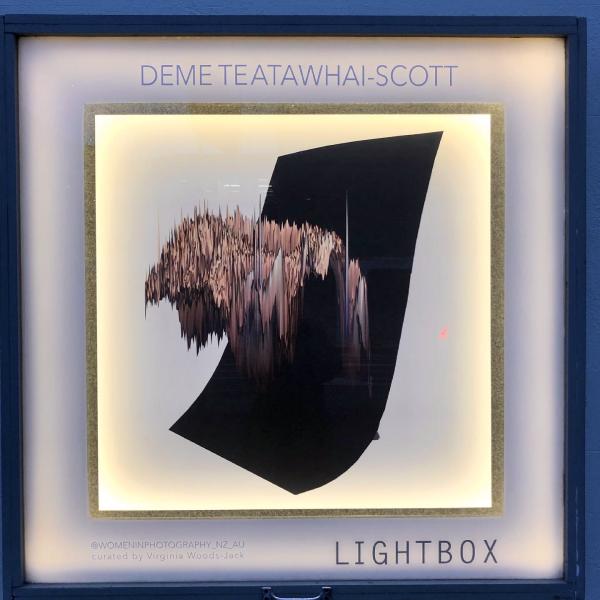
When looking to the future there is a responsibility to acknowledge where we have come from and how the past informs the future - more so than ever. In Carl Mika’s, ‘Overcoming ‘Being’ in Favour of Knowledge: The fixing effect of ‘mātauranga’.’ Educational Philosophy and Theory he states “The agenda of colonisation has been the constant presence of a philosophical colonisation between the self and things in the world, accomplished by educational practices which […] ideally suit the freezing of things in the world so that they yield information.” When I first arrived in Aotearoa in 2003 my understanding of colonisation was that it was a historical event that HAD happened not something that was still happening, being felt and lived by Māori in Aotearoa - I now know that that isn’t the case. I recently purchased the BWB book Imagining Decolonisation as the publisher states “This book seeks to demystify decolonisation using illuminating, real-life examples. By exploring the impact of colonisation on Māori and non-Māori alike, Imagining Decolonisation presents a transformative vision of a country that is fairer for all.”
It was this acknowledgement of the past and taking steps now towards a self-claimed future with a new vision that drew me to the work of Deme Te Atawhai Scott @de.teatawhai.scott the next artist in this project.
Deme Te Atawhai Scott - Taranaki, Ngāti Awa
D. Te Atawhai Scott is a photographer and filmmaker based in the Te Whanganui-a-Tara (Wellington) area. Scott works within the boundaries of the photographic medium to investigate the interwoven politics of identity and wā kāinga - home. Scott’s work derives from her mixed Māori and Pākehā whakapapa. After graduating from Massey with an Honors photography degree in 2019, she has stayed in Wellington to continue her practice. Scott’s work seeks to document the active liberation of decolonising forms of womanhood.
E hoa - Friend
This photograph is from a more extensive series The Children of Hineahuone, a photographic exploration repositioning wahine Māori as the storytellers of our whakapapa; this is an act of re-rooting ourselves to our whenua.
“Ko te maumahara kore ki ngā whakapapa o ōu mātua tīpuna, e rite ana ki te pūkaki awa kāore ōna hikuawa, ki te rākau rānei kāore ōna pakiaka.”
“To forget one’s ancestors is to be a brook without a source, a tree without its roots.”
E Hoa is a photograph that looks like the flesh tone geometric shape is emerging from the backdrop. This work actively re-envisions indigenous portraiture of wahine maori to resemble infographic maps referencing the creation of Hineahuone, the first wāhine moulded by clay in māori mythology. This series of rendered photographs of wahine maori maps the space between our whenua and ourselves, we too are created by the soil of papatūānuku, and our wairua will always belong to our soil.
we look to the future with progressive ideals - Wairata 2020
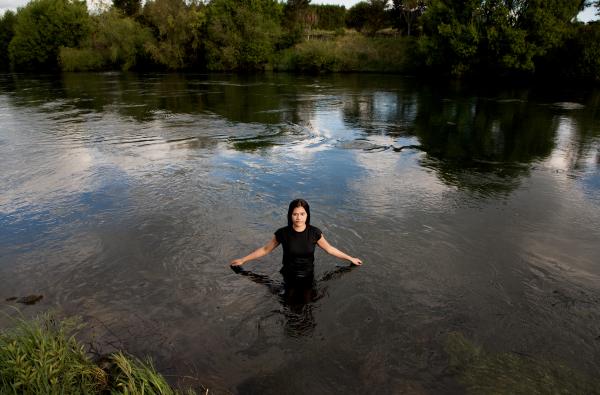
When you look up the word progressive or progressive ideals it tends to throw up references to social reform and political agendas. If we are looking to the future with progressive ideals, for me, this means Intersectionality, a term coined in 1989 by Kimberlé Crenshaw. As @unwomen explains ‘Using an intersectional lens also means recognising the historical contexts surrounding an issue. Long histories of violence and systematic discrimination have created deep inequities that disadvantage some from the outset. These inequalities intersect with each other, for example, poverty, caste systems, racism and sexism, denying people their rights and equal opportunities. The impacts extend across generations.’ During our lockdown I was introduced to (1977) THE COMBAHEE RIVER COLLECTIVE STATEMENT - I can highly recommend reading this - being able to view inequalities through a much broader yet more focussed lens it integral to a progressive future for us all.
Many of you will remember the recent take over by @saraormephotographer whose work is approached with an intersectional lens towards both feminist and Māori issues and she is our third artist in this 6 month long project which I am so proud of.
Sara (Hera) Orme’s sociology degree is an integral part of her documentary photography. Her korero exploring colonisation in Aotearoa, is informed by personal experience, the experiences of her whanau and the generations who have gone before them.
Her perspective is a paean to her wa kainga. Sara is based in Tamaki Makaurau with an endless rotation of visiting whanau amd we are very grateful for for her mahi and the depth of the kōrero that spring from Sara’s practice.
Sara (Hera) Orme
Ngāti Awa, Ngāti Turawhai, Ngāti Whakaue
Wairata Tahana -Te Teko- is part of an on-going work referencing my whanau in the small, predominantly maori populated town of the same name. A personal series, which began soon after the death of my father some 12 years ago, is rooted in my exploration of tipuna, whakapapa and the takaoraoratanga my father and the generations before us faced.
Wairata Tahana references both our heritage as Ngati Awa wahine and descendants of Kahupake and is a reminder that in 1865 on the the banks of this very river, our awa The Rangiaitaki, 100,000 hectares of Ngāti Awa land was stolen by the Crown leaving Maori landless, resources destroyed and leaving an entire people culturally and spiritually impoverished. Continuing this korero through my photographs has become essential to my work. It’s important for these stories to be shared and understood. I want this work to ignite more than a drive through experience of a small town in Aotearoa and only witness the visible impoverishment. Understanding history is essential to understanding the contemporary world.
Te Teko draws strongly on the complexity of colonialism in Aotearoa, The Raupatu, consequences of dislocation and assumes norms that are referenced from history, memory, whenua and my own relationship with Te Teko today. I am a visual sociologist researching and surveying these experiences in my photographs.
By understanding the past we can understand the present and look towards a future with progressive ideals.
To quote historian Vincent O’Malley; “It’s about taking ownership of our history, binding us together as a nation that can honestly confront its own past. We need to own this history. Doing that is not intended to sow the seeds of division or disharmony. It's the basis for genuine reconciliation.
we look to the future with progressive ideals - Sophie 2020

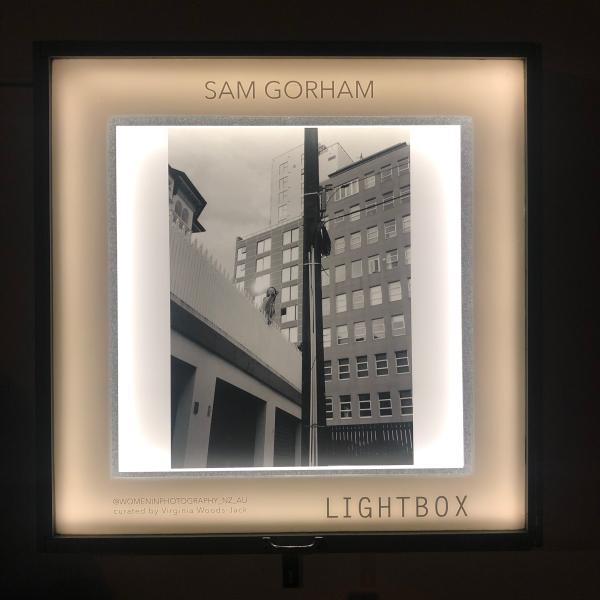
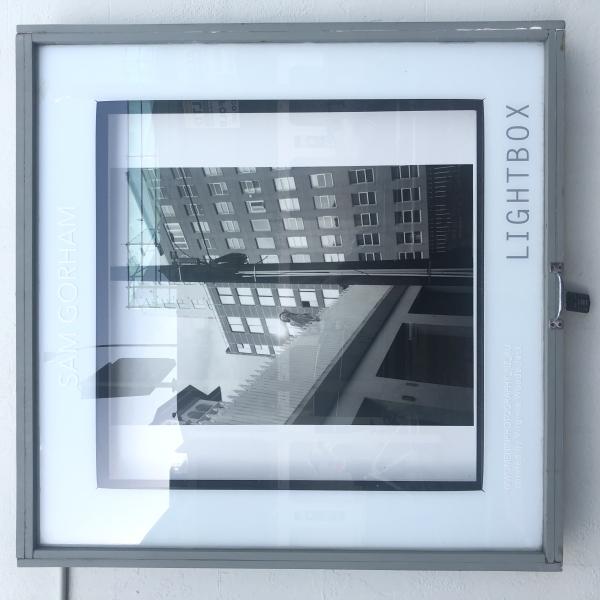
As this project developed I thought more about what progressive ideals might have meant in 1927 and who would have written those words and to whom they were addressed and would those ideals have encompassed the voices in this project. In Aotearoa at that point Women’s Rights were on the move, we had had the right to vote for over 3 decades. Women won the right to stand for Parliament in 1919, and in 1933 Elizabeth McCombs became the first woman MP. In 1927 Dr. Nina Muir, New Zealand’s first woman house surgeon, became the first woman president of the Medical Association of New Zealand. As we all know the journey to equality is a long and ongoing one, each generation has its own sense of purpose and drive knowing that the choices made and actions are taken before us impact on our present and in turn, our choices will impact those of the future.
With those thoughts in mind, I am excited to introduce our second artist Sam Gorham @gorhamsam. Sam is a Pākehā photographer and picture framer based in Te-Whanganui-a-Tara. She graduated Massey University in 2018 with a Bachelor of Design majoring in Photography. Her ongoing works include: history of materials in Aotearoa, online surveillance and its ethical dilemma, and self-identity.
Work: Sophie, 2020.
Excerpt from This is not an exit, 2018-ongoing.
This is not an exit, as a series, began to take shape when I noticed patterns in my recent photographic works tied to mental distress. The photographs are vernacular, subconscious photographic firings in response to my emotions at the time of shooting. Often I am hit with “photographers regret”, wherein a sublime moment will pass in front of my eyes uncaptured. During depressive states, I swing between completely obsessed with not losing anything and entirely unphased if I were to never photograph again.
Sophie was captured, hovering over the edge of Rachael’s balcony, during lockdown in 2020. I remember how I felt about that photo as soon as I took it - I wanted it to be an exact portrayal of my feelings at the time. At that time, and the same within other photographs of the series, looking to the future seemed extremely foggy. In showing these images I offer a sense of self-awareness and wanted connection.
We are looking to the future with progressive ideals poses an interesting statement, one of the collective sights set on a future - foreseeable, unimaginable, or tangible?
The images I've chosen reflect a slow progression of societal understanding towards mental wellbeing; a change witnessed in street vandalism, bonds of friendship in hardship, self-healing, and self-awareness or recognition. Colourless film documents a double entendre of “black and white” thinking, often applied to people with mental distress by those who have little understanding of the subject matter.
We look to the future with Progressive Ideals - Bring Everything Today 2021
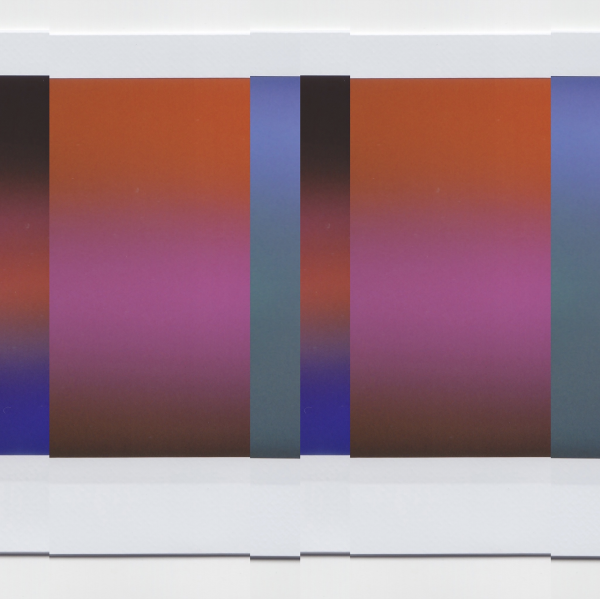
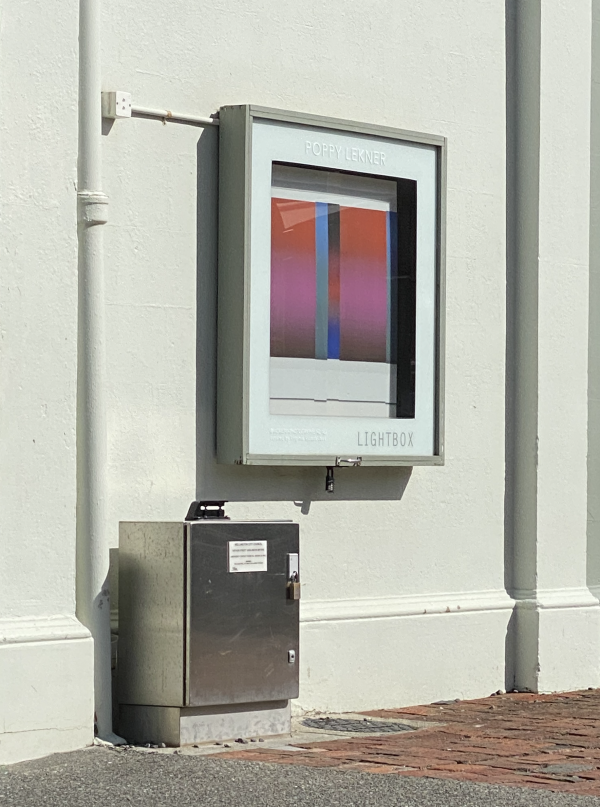

When thinking through this project, which artists to invite, and my hopes for a real-world window into an ongoing online project, I spent time sitting looking at the lightbox on the side of Thistle Hall as well as looking through the Women in Photography NZ & AU feed based on Instagram.
For those of you who know the building and the wall, the Lightbox sits on there is, a quote taken from a letter from hall management to City Engineer dated 2nd August 1927 where they state ‘We are looking to the future with progressive ideals’. 94 years later this gave me the words that weave through many of the themes of the 88 artists who have shared their work to date. Of these 88 I have chosen 8 artists from Aotearoa, 1 now resident in England, whose work resonates with a future I want to be a part of founded on more progressive ideals. Ideals and ideas of connection and reconnection to Whenua and self, acceptance, decolonisation, acknowledging the layers of history, our present and how everything we do now informs our future.
Over the next 6 months, you will have the opportunity to experience the work of 8 artists - a singular image from each, present and visible day and night - here in Te Whanganui a Tara Wellington. Each image is a glimpse into the artist's practice and the wider community of WIP NZ & AU - a platform highlighting female/identifying and non-binary creators working in photo-based arts in NZ & AU. Engage. Connect and Debate. An invitation for you to explore further. Please do join us online for further discussions and at the conclusion of each artists work we will be hosting an Insta Live between the curator Virginia Woods-Jack @virginiawoodsjack and the artist.
I am excited to announce that our first artist is Poppy Lekner @poppylekner based right here in Te Whanganui a Tara.
Poppy is an experimental process artist - after art school she started working with her grandmother’s books making these into biographical sun-based photograms on silver gelatin paper, since then her work has evolved to use light and object in many different ways - mostly cameraless. Her recent work has focussed on colour fields and synthesised landscape. In 2020 she was part of the Struck By Light exhibition as part of the Royal Photographic Society 100 Heroines Project in the UK, The International Alternative Processes Exhibition in New York and the winner of The Parkin Drawing Prize, later this year her work will feature in the Struck By Light show in Barcelona. She lives with her husband and their three kids in Te Whanganui-a-Tara Wellington. Stay tuned for a post later today when we will reveal Poppy’s contribution to this project.
Poppy writes of her piece.
My work "Bring Everything Today’, 2021 from The Glow Series is an imagined landscape made of pieces flipped and upright but without up and down, constructed in complete darkness using light and film. This work is about sense making and moving forward with a deeper sense of place through making creative connections through experimentation and reflection, in my own way “looking to the future with progressive ideals”.
Maggie Smith’s poem relates to this possibility “How Dark the Beginning”…
All we ever talk of is light…
…let me speak on behalf
Of the good dark. Let us
Talk more of how dark
The beginning of the day is.
Untitled
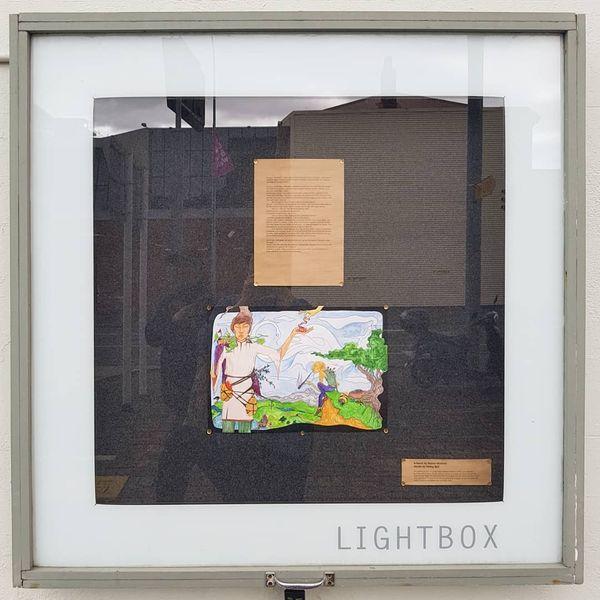
This lightbox project is a collaboration between artist and writer, lover and lover, boyfriend and girlfriend. It’s like raising a sapling from seed. Like observing new life, stem and leaf: adapt and interact with its environment. Like the careful pruning of a tree. Then plucking at the plant for its fruit and gnawing at its seeds. So with the seeds, the cycle of creation and collaboration can begin anew.
26th June 2019 - Badlands National Park, South Dakota
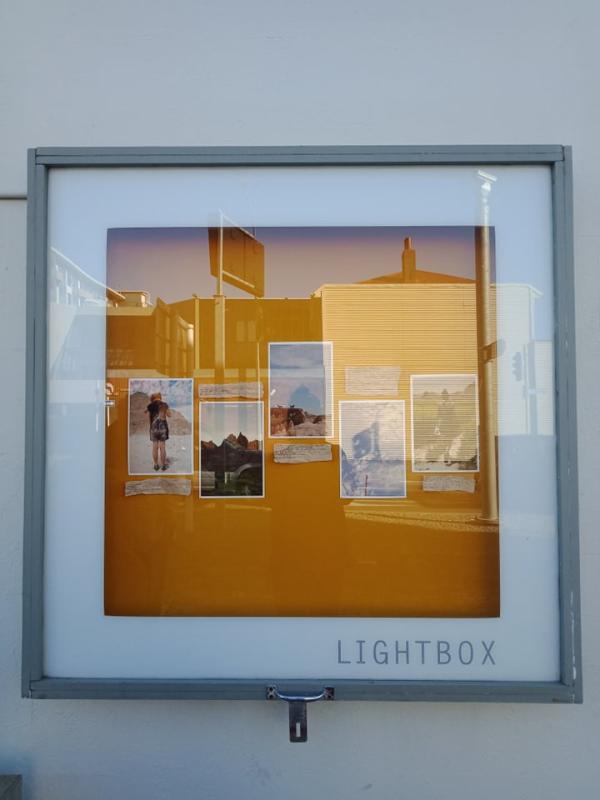
Lightbox is pleased to present '26th June 2019 - Badlands National Park, South Dakota' by Anna Persson, on until the 23rd of December and curated by Melina Payne.
Artist Anna Persson explains:
"I've always held a deep love and admiration for landscapes - both internal and external. This year, I embarked on a life-changing journey across the United States with my pal, Alissa. We hitchhiked over 5000km from Wisconsin to Oregon with journals, instruments, and a camera. Four days into our adventure, we found ourselves in the surreal Badlands National Park - our lives forever changed by hiking through the desert and later surviving a lightning storm in a $20 tent! These photographs and reflections are from that day - 26th June 2019 on the Castle Trail in the Badlands National Park, South Dakota." Anna Persson is an all-round creative bean hailing from the most isolated city in the world (Perth, Australia). When not chasing Summers in the Northern Hemisphere, she can be found embracing Summers in her adopted home of Wellington, New Zealand. Anna's work marries her vagabond lifestyle and passion for travel with her sense of whimsical joie de vivre.
bach no. 7
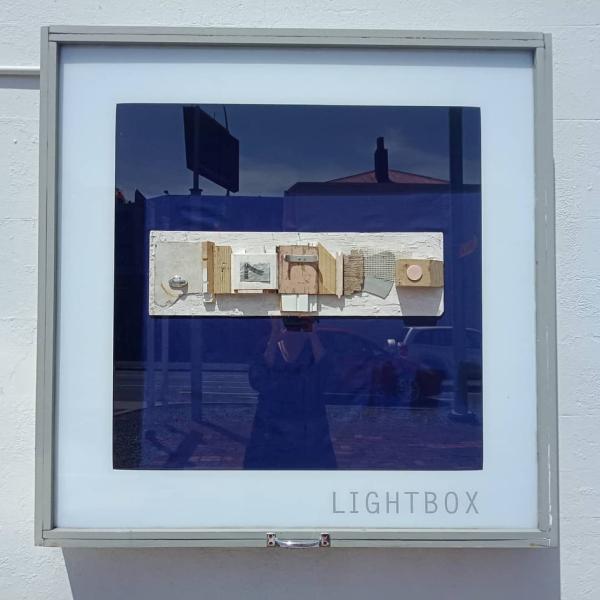
Lightbox is pleased to present 'Bach No. 7' by Nadine Meyer with accompanying text by Sophie MacDonald, showing until the 6th of December and curated by Melina Payne.
Artist Nadine Meyer explains:
"'Bach No.7' is one of the found object assemblages from my 'Baches series'. These works represent the New Zealand phenomenon -- the bach -- a small, often very modest holiday home or beach house. I made 'Bach No. 7' wanting to preserve the beauty of old baches with their eroded, faded, broken, chipped, fringed, rusted materials by incorporating them in my work. Each of my pieces are assembled similarly to the way the original baches were/are constructed -- they are small in size, adopt a square-like form and are largely made from found objects and cheap or recycled materials; most of which were collected either from site of the property where I live or the beach nearby."
In their response named 'Fantastic Voyage', Sophie MacDonald writes:
On the fringes
eroded and distorted, she will stay;
chipped teeth, chewing on sand
and a gritty tongue, licking, lapping,
Pawing, at the porch.
Though, her fixtures – askew,
she will not weep.
Floorboards bowed and bowing
to the weight – of the air,
saturated, with salt – or perhaps –
the echoes, the chatter
of children, or ribs, cracking;
Does she tow her own ghost?
We, paralian children, are clever; we know
that though the wind may buckle her bough,
it will not break her.
Resilience, rust,
with a head upon her breast,
we will fall;
asleep.
Though nobody is home
she will reserve the right
to take a new name.
Sophie MacDonald is a student that grew up in a small rural town in the King Country, before moving to Wellington to pursue studies at Victoria University. She has been interested in writing since a young girl but didn’t start writing poetry until her time at university. While she loves writing, Sophie also explores other mediums of art, such as painting, ceramics, and drawing, when time allows it.
Untitled
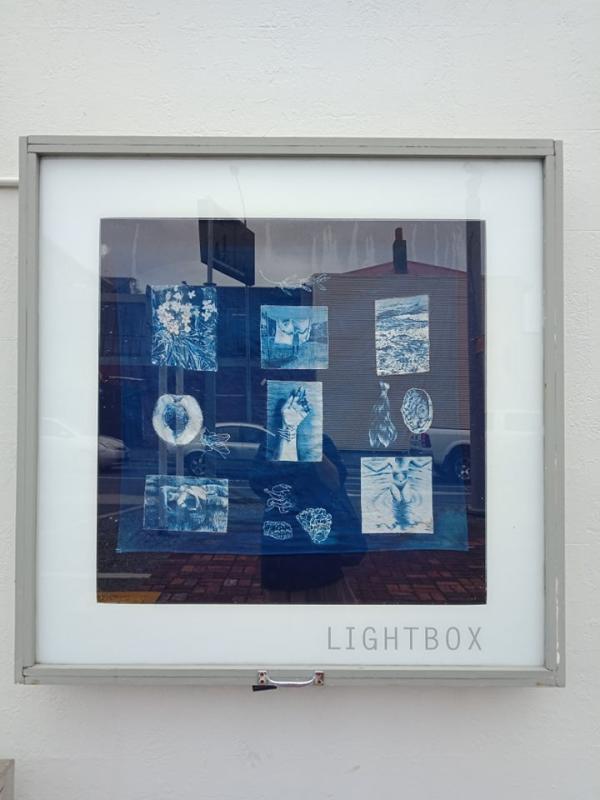
Lightbox is pleased to present the work of Alice Fennessy, showing until November 22nd and curated by Melina Payne.
Artist Alice Fennessy explains:
"My work aims to use the cyanotype medium to mark the passing of time, and to explore the uncertain nature of memories; the ways in which dreams, reflections and experiences collide and conflate when recalling moments in time. In it, several drawings are compressed onto the surface of the single work, referencing dream images, fragments of memory and late night thoughts."
possum hunting
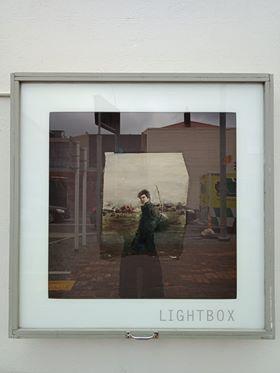
Lightbox is pleased to present "Possum Hunting" by Nicholas Burry with accompanying text by Anique Jayasinghe, showing until November 7th and curated by Melina Payne.
Artist Nicholas Burry explains:
"Possum Hunting" is an ‘imagined’ self portrait which attempts to capture a feeling of my own childhood memories and perhaps a misplaced nostalgia. Memories of forming precocious militias with friends and family. Setting out to hunt and kill possums, which in the narrative became this vague existential threat, only ever glimpsed. Equipped with homemade bows of green wood that would bend and never return to their original shape or snap outright.
But it seems in hindsight, the objective was only the fantasy (and I'm thankful we never actually caught anything). To me there's a tension in the scene, the character, too old for the game, the mood, a little too serious. Aspects of this work were painted using a photographic reference from a camping trip I went on when I was about 18. While other components were painted from imagination. I think on that level the work is accurate, in the way that as we repeat memories to ourselves, they begin to distort. Borders and space begin to dissolve until it is only an unspecific setting which the principal actors/events inhabit. These memories seem to Myths."
In response, Anique Jayasinghe writes:
How do you remember your younger self?
Is that how you saw yourself then?
Burry’s reflective portrait of his eighteen-year-old-self prods at these questions of self-perception and memory with a hint of humour and nostalgia. Pictured centrally, the heroic figure looks back at us, bow hoisted upon shoulder and coat collar flared in the wind, as if beckoning us to join the hunt.
We know this game of make-believe. The scenery of our adventures may have been different to these hazy Canterbury plains, but the rules of conjuring are universal. Perhaps even primal.
Possum Hunting recalls childhood fantasies through Burry’s early experiences of faux hunts with siblings clutching makeshift bows. Viewers are lured into recollecting our forays into imagining more of our physical boundedness - where the stairs were once a treacherous climb through a mountainous valley and that cardboard box was a portal through time.
Our missions into the wild unknown were as romantic and earnest as this figure’s expression, and yet simultaneously, the artwork belies this with tongue-in-cheek hindsight. As Burry reflects, “…the objective was only the fantasy (and I'm thankful we never actually caught anything).” The work further interrogates whether all such supposed ‘childish’ fantasy is behind us. We are reminded of how we all, to varying degrees and outcomes, mythologise about who we were, are and will be.
This mutability of identity and memory is rendered aptly with Burry’s use of medium. The combination of gestural oil stick and paint with utilitarian builder’s paper reacts to desaturate colours and steep the overall composition in a foggy flux. Our piecing together of amorphous memories long past, parallels the disjointed borders and roughly torn edges framing the moment in question.
And with all this in mind, I wonder;
How do we reconcile memories of younger selves with who we are now?
Untitled
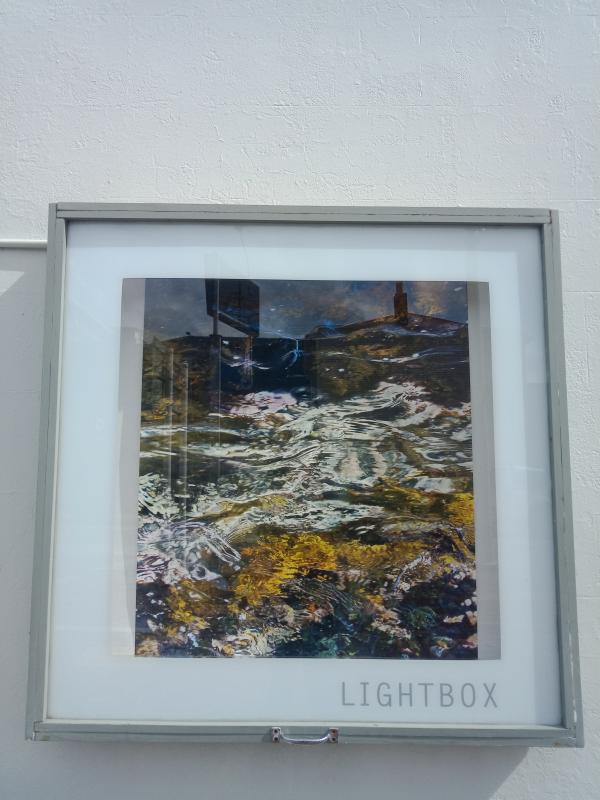
This fortnight, Lightbox is pleased to present the work of Christina Little and the writing of Talia Merrin. Both running until October 25th and curated by Melina Payne, Talia writes in response to Christina's work creating a dialogue between image and text.
Artist Christina Little explains:
"This is a photograph taken at Rocky Bay, Porirua. The image is both familiar, yet ambiguous. I liked the idea of isolating a specific fragment of the shoreline and removing the context from the viewer."
Christina Little is a New Zealand born artist photographer based in Wellington. Christina creates contemporary photographic works through the isolation of nature’s movement, light, shadows and textures. Her work usually includes both creative investigation and learning about the topography and natural history of the location, this has included Marlborough Sounds, and the Greater Wellington region. Christina’s images are both familiar, yet ambiguous. They play with our perception of scale and reality; and could be perceived as microscopic studies or macroscopic bodies. Christina’s prefers to use the camera hand-held rather than on a tripod, giving her greater control when capturing where the natural movements are in the subjects producing painterly and lyrical abstractions.
In response, Talia Merrin writes:
There is a world before me now
So viscerally I see
Shimmering
Each colour a kingdom below the sea
Reflecting an inbetween
Where two lights meet.
I look from above
But imagine my feet
ankles deep
As they dip and sink
Into the salt
Into the sand
Into a pool
Shallow
But life how it seems
The colours steep
The colours flow
The colours create
Pockets
Pockets, that mirror everything
White also hiding
There is so much more to see
These waters
Cool and crisp
Not warm and sweet
My breath leaves
Picked up by the wind
Rippling the surface
Together they snicker
Whispering something other
Something wild
To those by the shoreline
They want to claw the rocks underneath
Shape underwater pottery
Stealing the colours
For selfish artistry.
eye of the bovine
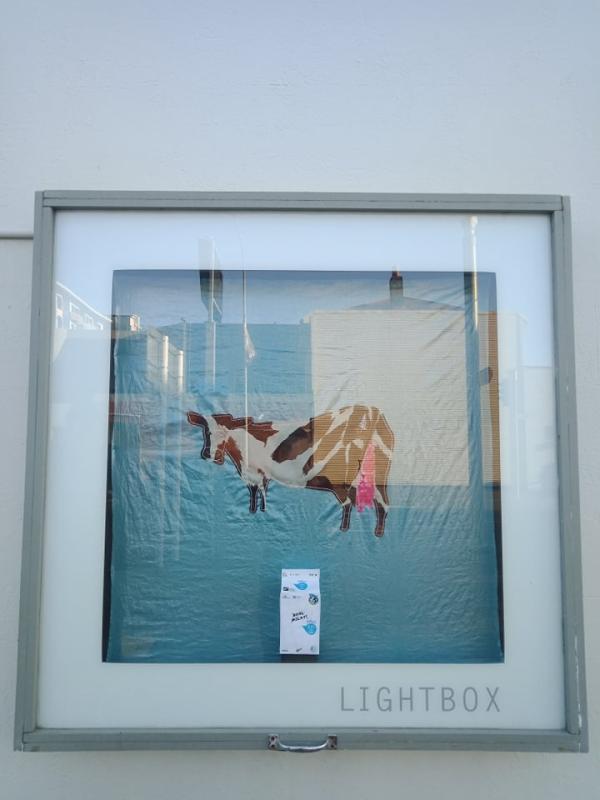
Lightbox is pleased to present 'Eye of the Bovine', a growing collaborative show by Sabina Rizos-Shaw and Siân Stephens, on until the 11th of October and curated by Melina Payne.
'Eye of the Bovine' is an exploration of a satirical approach to activism through multi-media art about the ethical conundrum of animal agriculture, drawing from Rhydian Thomas's not-so-fictitious universe of Milk Island.
Beginning with Siân's milk carton, Siân and Sabina will take turns producing an artwork for Lightbox. This will see Lightbox slowly fill with more work as time progresses, creating a dialogue between the two artist's practices.
About the artists:
Siân Stephens is a painter and video artist whose practice explores the unseen and disturbing realities of animal agriculture. The underlying tone of the work is activism based, and the subject matter is an honest display of the unnatural experiences of cattle in the process leading up to beef and milk appearing on the supermarket shelves. All the work is made in the hope that, if discovered through a visual art platform, the viewer is inspired to re-evaluate their relationship with the animals that are so lavishly used as resources; a truthful and confronting appeal for compassion, through large scale oil paintings and graphic video art. A desire to open critical discussion on how the consumption of animal bi-products became normalised, is the artist’s foremost intention.
Sabina Rizos-Shaw is a Wellington based artist who recently finished a Fine Arts Honours degree at Massey University. Her practice is focused around textiles, painting and sculpture. She uses the process of creating to work through personal feelings, employing humour and a certain mediation to obscure sincere undertones, aided by her use of a bright, naïve aesthetic. Often the work is somewhat a pastiche. She enjoys exploring themes of construction and articulation of the self, construction and articulation of artworks, overcoming trauma, as well as performance and viewer participation.
In response, Sarah Robinson writes:
Me: “What do you think about the dairy industry in New Zealand?”
Most people: “I don’t know… I’ve never really thought about it before, I guess.”
A fairly innocuous question, but perhaps it’s a little more than that. For most people, we know the dairy industry exists and we know it’s a huge part of Aotearoa’s economy and livelihood, but I’d hazard a guess that not a lot of us think about it beyond this. I know I don’t.
Eye of the Bovine encourages us to think a little more closely about this all-important, true-blue, hard-yakka Kiwi industry, the choices we make that relate to it and the assumptions we hold about it. It’s not an attempt at sermon, lecture, criticism or guilt-trip; it’s an invitation to a conversation about the ethical conundrum of animal agriculture. The works’ satirical and extreme nature is intended to draw attention to issues that should be more widely talked about and acknowledged: the animal ‘other’ and the female body, exploitation, trauma, consent, national identity and the importance we place on this industry, nationalism and capitalism, the normalization of certain practices in Aotearoa, and the perceived ‘need’ for dairy products and the lengths we go to to have them.
Sian and Sabina’s styles are very different, Sabina uses textiles, sculpture and painting to bring her ideas to life, while Sian employs painting and video to express hers. Sian’s works are often beautifully crafted but fundamentally difficult to look at. Sabina’s are subversive and ironic, pulling viewers in to a new state of mind, an alternative way of looking at things. The juxtaposition and accumulation of the works is itself a conversation; the artists speak to each other and respond to each subsequent work with another of their own, thereby continuing the conversation beyond the different media they use. The artworks themselves are also a point of conversation; you may love or hate them, or you may remain indifferent, who knows.They are designed to be humorous and satirical in a way that makes art and activism simultaneously accessible and profound, and we hope that, at the very least, they incite something in you - maybe just an internal dialogue or maybe one that you share with others, that’s up to you.
Sian and Sabina’s collaboration is born out of a desire to address the above issues, as well as a mutual understanding and wariness of the industry and what it means for the animals at the center of it. Working together previously on several projects, this topic arose naturally for the pair. Sian’s interest in the rights of cows spans three years and extends to of her wider practice, while Sabina’s interest in satirical art brought her onto the scene just a few months ago; the works are inspired by Rhydian Thomas’s Milk Island and their own personal perspectives on cows, art and activism.
After working together on a group show, Atom Heart Mother, these ideas became a conversation and have further developed into Eye of the Bovine. The works are a nod to both Thomas’s intriguing and illuminating collection of stories, and an exploration of their own agri-sentiments. It is now our turn to take part in this conversation, thinking perhaps a little more critically about how we engage with dairy in New Zealand. At the same time, though, maybe you don’t want to think more critically, maybe you already are or maybe you’re happier not thinking about it at all. Either way, you’ll hopefully think about your response to my opening question and to these artworks, and maybe that’s enough. The point is: this exhibition doesn’t seek to shock or disgust people into agreeing with the artists, it seeks to draw out your own personal and organic reactions and leave you to fill in the blanks. Or to talk about it with others, and spread that seed far and wide.
As the conversation progresses, and as each new work is added, I’ll write a little something here in response. Please feel free to do the same by submitting feedback in whatever way you see fit, by using the hashtag #ilovemilkymoo. Remember that the cows won’t ever get this opportunity, so it could be up to you to speak for them.